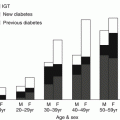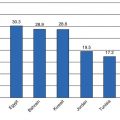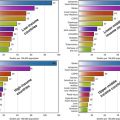Country
Proportion (%)
Major ethnic groups
France
6.4
North African, South East Asian
Germany
8.5
Turkish, Italian, Greek, Polish
Italy
3.2
African, Asian, Eastern European
The Netherlands
4.7
Turkish, North African, Surinamese
United Kingdom
7.9
African (Caribbean, East African), Indian, Pakistani
Recording of ethnicity has not been uniform through time and between countries. Early on, ethnicity was assessed based on the country of birth or original citizenship or place of birth of the parents. However, this has changed in some European countries over the last two to three decades due to more modern concepts of ethnicity and also the fact that there are now third and even fourth generations of immigrant populations who were born in Europe. While an updated and modern concept of ethnicity is appropriate to better inform about specifics of health-care disparities, it makes it difficult to compare old and new findings in the literature, as well as between countries with differing concepts, unless one has access to the original definitions and raw data.
Diagnosis and Pathophysiology
The methods of ascertaining the diagnosis of diabetes in reports have been varied; the diagnosis of diabetes or prediabetes has been based on self-report or on glucose/HbA1c screening, often in high-risk groups, according to the recommendations by the EASD/ADA, or it has been based on reports to registries from participating physicians. The majority of subjects suffer from type 2 diabetes which has been consistently reported to occur earlier (by up to two decades) in minority populations. The pathogenesis of type 2 diabetes appears to be related to increased caloric intake, to (central) obesity, and to insulin resistance and beta cell failure, and these do not appear to be different between populations. The excess incidence of diabetes in South Asian women correlates with more prevalent central obesity but this is not the case for men [51, 52]. One study estimates that up to 90 % of Asian immigrant women may be at risk for diabetes [21]. The most and the earliest data supporting this statement come from studies in subjects of South Asian ethnicity; more recent studies from Turkey do confirm and extend these results to other ethnic minorities [44]. However, when waist circumference is used to assess central obesity, the risk for diabetes in South Asians significantly increases at lower values compared to African or Caucasian populations. In addition, it has been proposed that differences in suppression of nonesterified fatty acids may act as mediators of glucose intolerance in Indian Asian populations [40]. In minority subjects of African descent as compared to subjects in the country of origin, increased caloric intake from protein and fat has been shown to be associated with higher rates of diabetes [2]. Similar findings have been reported in migrants from South Asia (Pakistan and Sri Lanka) who settled in Norway [54]. This pattern of increasing food consumption is similar to populations in developing countries who move from rural to urban settings with an increase in calorie consumption and more sedentary lifestyle [45].
Prevalence Estimates
The prevalence of diabetes in minorities is affected by ethnicity and country of residence. In one study in the UK [59], standardized prevalence rates for diabetes were 1.7, 5.3, and 8.9 % in white, African Caribbean, and Pakistani/Bangladeshi groups. In a more recent study [51], incidences of diabetes over an up to 20-year time period were 14 % for European, 33 % for Indian Asian, and 30 % for African Caribbean subjects. Based on these findings, it is estimated that by age 80, approximately 50 % of Indian Asian and African Caribbean subjects versus approximately 20 % of Europeans will have developed diabetes. A study from Oslo, Norway [25], compared the prevalence of diabetes between South Asian and Western subjects in a low-income population; diabetes prevalence rates were 27.5 % and 2.9 % for South Asian and Western women and 14.3 % and 5.9 % for South Asian and Western men, respectively. The age-adjusted odds ratios for South Asians versus Westerners were 11.0 for women and 3.0 for men; adjustment for waist-hip ratio reduced these ratios to 7.7 and 2.6 in the South Asian women and men, respectively.
A study from Amsterdam [47], Netherlands, compared the prevalence of diabetes between Dutch, Turkish, and Moroccan subjects. Unadjusted diabetes prevalence rates were 5.1 %, 11.0 %, and 18.8 % in Dutch, Turkish, and Moroccan men, respectively; unadjusted diabetes prevalence rates were 2.9 %, 8.4 %, and 16.1 % in Dutch, Turkish, and Moroccan women, respectively. A different study from Amsterdam [7], Netherlands, that was conducted around the same time compared the prevalence of diabetes between Dutch, Hindustani Surinamese, and African Surinamese groups. Age-adjusted prevalence was 5.5 %, 14.2 %, and 26.7 % for the Dutch, African Surinamese, and Hindustani Surinamese groups, respectively. In a univariate analysis, a history of CVD and waist circumference demonstrated the strongest association with diabetes. In a multivariate analysis, a history of CVD, a first-degree relative with diabetes, and Hindustani Surinamese were the strongest determinants of diabetes. While increased rates of diabetes have been found in groups of Indian and African descent in England and the Netherlands, it appears that these minorities living in the Netherlands have almost twice the prevalence than that observed in England [1]; it is unclear whether these differences between countries are due to differences in the studied populations (e.g., genetic or social/ethnic variability) or due to differences in the environment.
Germany has the second highest number of diabetic subjects in Europe (IDF-Atlas 7th edition 2015) after the Russian Federation and with Austria and Spain the highest population prevalence in Western Europe. There are few studies assessing the prevalence and incidence in ethnic minorities in Germany which is due to privacy laws as well as the way these data are collected. Most of these studies are small and likely affected by sampling bias. The estimate for diabetes prevalence in Turkish subjects has been reported in a range from 3 %, which is lower than the prevalence in native Germans, to 14 % which is 50–100 % higher compared to native Germans (Icks et al. Deutscher Gesundheitsbericht Diabetes 2011, pp 148–154; www.diabetesde.org). Most experts agree that the prevalence of type 2 diabetes is likely to be higher than in the native population [43], where it is assumed to be 7.2 % [18].
Roma, in earlier literature referred to as gypsies and travelers, do most likely represent one of the oldest of all migrant minorities in Europe; it is well documented that they do have poorer health and decreased life expectancy. One study from England [39] demonstrated a 4.0 % self-reported prevalence of diabetes in the gypsy/traveler group which was not different from the native group. In contrast, a study from Hungary [20, 31] reported an 18.4 % prevalence of undiagnosed diabetes, nearly one-and-a-half-fold higher than the 7.5 % observed in the native Hungarian population.
Gestational diabetes seems to be more common among ethnic minorities, e.g., among Turkish women in Germany (183 per 1,000 pregnancies compared to 138 per 1,000 pregnancies in German women) [42]. Rates of gestational diabetes have been reported to be elevated also in groups of South Asian and African descent whether they lived in Norway [26] or in other countries [27]. This may explain some of the increased perinatal complications seen in minority groups [29].
Children of migrants are often more obese and more sedentary suggesting an increased future risk of type 2 diabetes. For type 1 diabetes, however, it appears that children born to immigrants have a lower risk [13, 22, 23]. However, minority children with type 1 diabetes have worse glycemic control, more severe hypoglycemic episodes, and a higher rate of hospitalization [46].
Complications of Diabetes
Few data are available regarding diabetic complications in different ethnic groups. The available data indicate that Asian Indians suffer more from retinopathy and nephropathy compared to the native populations. In subjects in the UK with early onset of type 2 diabetes (age <40 years), South Asians exhibited more retinopathy (17.5 % vs. 7.9 %) and more nephropathy (18.1 % vs. 7.8 %). In the same study [8], macrovascular disease was also more prevalent in the South Asian group (15.7 % vs 9.4 %). These results were confirmed in a larger and more recent study [49] that observed a 52 %, 42 %, and 38 % prevalence of any diabetic retinopathy in African/Afro-Caribbeans, South Asians, and white Europeans, respectively. In the same study, sight-threatening diabetic retinopathy was also nearly twice as common in both African/Afro-Caribbeans and South Asians compared to white Europeans. Diabetic nephropathy was reported in several studies to progress more rapidly in Asian Indians [11, 12] with the latter study observing a 40-fold increased risk of end-stage diabetic nephropathy compared to the native Dutch population. However, more recent studies were not able to confirm higher rates of complications [19, 56] or faster progression of renal disease in minority groups [38]. While ethnic differences may be explained, at least in part, by the higher prevalence, earlier onset of diabetes, and higher glucose levels, those variables do not appear to completely account for the differences.
Coordination and Delivery of Diabetes Care Services
Health care is almost universally available in all European countries and includes diabetes care and education, and the patients’ expenses for their care including medications are often negligible. All health-care services do have guidelines for diabetes care that are modeled after ADA/EASD recommendations. Nevertheless, for a number of reasons that are not all well understood, minorities do not obtain the same benefits from the health-care system as their native counterparts as often evidenced by higher average glucose levels and lower attainment of treatment goals for other cardiovascular risk factors such as hypertension [19].
Data on health-care delivery and utilization in minorities are scarce, mostly due to lack of recording ethnicity in the primary care setting [5]. One study [15] revealed that Indian patients with diabetes were less likely to be seen by a primary care physician, but a later study [36] showed no differences in access to health care for diabetes between white and South Asian Indian groups. However, the latter study showed a tendency toward lower control rates of diabetes in the minority groups. A study from Italy [4] supports these findings in minorities; while minorities with diabetes were cared for in similar proportions as the native population, they were less likely to be tested for HbA1cA and had worse glucose control.
A number of barriers to health-care delivery have been identified [35, 55] (Miriam McHardy – Master Thesis Necessity, Concepts and Feasibility of Culturally Tailored Diabetes Education for Migrants in the Netherlands and the United Kingdom: A Qualitative Study on Experts’ Views); they include language barriers and lack of transportation (driver’s license and car), especially in first-generation immigrants and subjects with low educational status, low health literacy, and cultural and religious norms [58], as well as differences in illness perception between patients and providers [57] (Table 12.2). Even if advice is provided in a culturally appropriate context and understanding, implementation of changes can be a struggle within the routines of already established food habits [14].
Table 12.2
Potential barriers to health-care delivery
Language |
Different perception of illness |
Low health literacy |
Low educational status |
Cultural norms |
Religious norms |
Lack of acceptable healthy food choices |
Lack of transportation |
Efforts to overcome those barriers come from both the provider (health-care delivery) and the consumer side. For example, case workers and “community links” have been shown to improve diabetes care and outcomes. The use of translators [48] can improve communication of certain issues and concepts but also has the potential to change the tone of the conversation by removing humor and adding the interpreter’s own opinions. Self-help groups and social clubs are used by minority patients to improve self-management of their diabetes [16], but not all minority groups find them acceptable.
Non-pharmacological Management
Diet and exercise are the cornerstone of any diabetes treatment regimen; it is also the cornerstone of diabetes prevention. Diet and exercise have been shown to improve glycemia and lipids in ethnic minorities and prevent progression to the metabolic syndrome [50]. There are no studies comparing the efficacy of these modalities between native and minority populations. As pointed out above, minority groups face additional barriers when attempting to change eating and exercise habits; healthy food items have to be available, affordable, and useable for established food patterns. Increasing physical activity can be difficult for some minority groups, especially women who are not permitted to show body parts or exercise in the company of men. Because of these additional barriers, it is important to develop and deliver culturally competent diabetes care interventions [58].
Rational Selection of Antidiabetic Medications
Drugs for the treatment of diabetes are available to all subjects diagnosed with this disease and cost is covered completely in most countries. Most common older and newer diabetes drugs are available in Europe where the European Medicinal Agency is in control of approving the applications for marketing by the drug companies; however, coverage and reimbursement rates of drugs are decided separately by the unique regulatory agencies in each country which affects utilization by the patients. There are no studies comparing efficacy and safety of different antidiabetic drugs between immigrant and native populations, and, therefore, no recommendations in regard to the first- and second-line choices can be made. In the absence of studies that could provide guidance for drug selection and in the absence of significant differences in the pathophysiology of diabetes development between immigrant and native populations, drug prescription should follow the guidance by ADA/EASD. A study from the Netherlands [10] showed underutilization of diabetes drugs in Turkish and Moroccan immigrants but not in Surinamese and Antillean immigrants. A study from England [6] provided a more granular listing of the use of antidiabetic drugs; the utilization of oral drugs, predominantly metformin and sulfonylurea, was similar between groups. However, minorities were less likely to utilize insulin alone or insulin plus oral drugs. The utilization of lipid-lowering and antihypertensive drugs was similar between groups. Lower utilization of insulin and lipid-lowering agents in migrants was also reported in a study from Italy [34]. The reasons for these differences, especially the lower rate of insulin use, are not clear; this may be due to the younger age of immigrants, lower prescription rates by the providers, or lower acceptance by the patient. Additionally, based on the results from a large Austrian/German registry study, there is a difference in the utilization of continuous insulin infusion therapy between Turkish and German/Austrian children [24]. The fact that this “underutilization” occurs in the face of universal health-care coverage points to social and cultural issues in the ethnic minority groups that are not well understood. Whether this underutilization of insulin pump therapy contributes to worse glycemic control, more severe hypoglycemic episodes, and a higher rate of hospitalization [46], as pointed out above, is not clear.
Translating Primary Prevention of Type 2 Diabetes
Ethnic minorities are at high risk of developing diabetes; it is estimated that half of Indian Asian subjects may be diabetic by age 80. Therefore, prevention of type 2 diabetes is of utmost importance in these groups. Progress has been slow in part due to barriers that are present in those groups; in addition, different barriers exist in minorities from different origin. Johnson et al. [28] describe a number of these barriers such as lack of access to exercise facilities, family and work commitments, cost, language, religious differences, and cultural norms; in addition, differences in illness perception contribute [57]. Taking these considerations into account [53], one prevention study that adapted the design of the Finnish Diabetes Prevention Study in a culturally sensitive way was conducted in Scotland. The study was unable to recruit sufficient numbers of participants to assess the effect of the intervention on progression to diabetes; the (revised) primary question was whether clinically meaningful weight loss can be achieved. The results of this 3-year study, the PODOSA (Prevention Of Diabetes and Obesity in South Asians), demonstrated more weight loss associated with a decrease in central obesity and a trend toward lower fasting and 2-h post OGTT values; importantly, there was less progression to diabetes, and this has to be taken with a grain of salt since the study was not powered to view this result with sufficient confidence. A similar diabetes prevention study, the DH!AAN study, in Surinamese Asians is currently underway in the Netherlands [37] (Health Promotion International, Vol. 29 No. 4). The results of the PODOSA and the DH!AAN study will be compared with those of a similar, currently ongoing study in India, the D-CLIP study [3]. Together, the results will guide development of more targeted diet and exercise programs to prevent diabetes in these populations.
Stay updated, free articles. Join our Telegram channel

Full access? Get Clinical Tree








